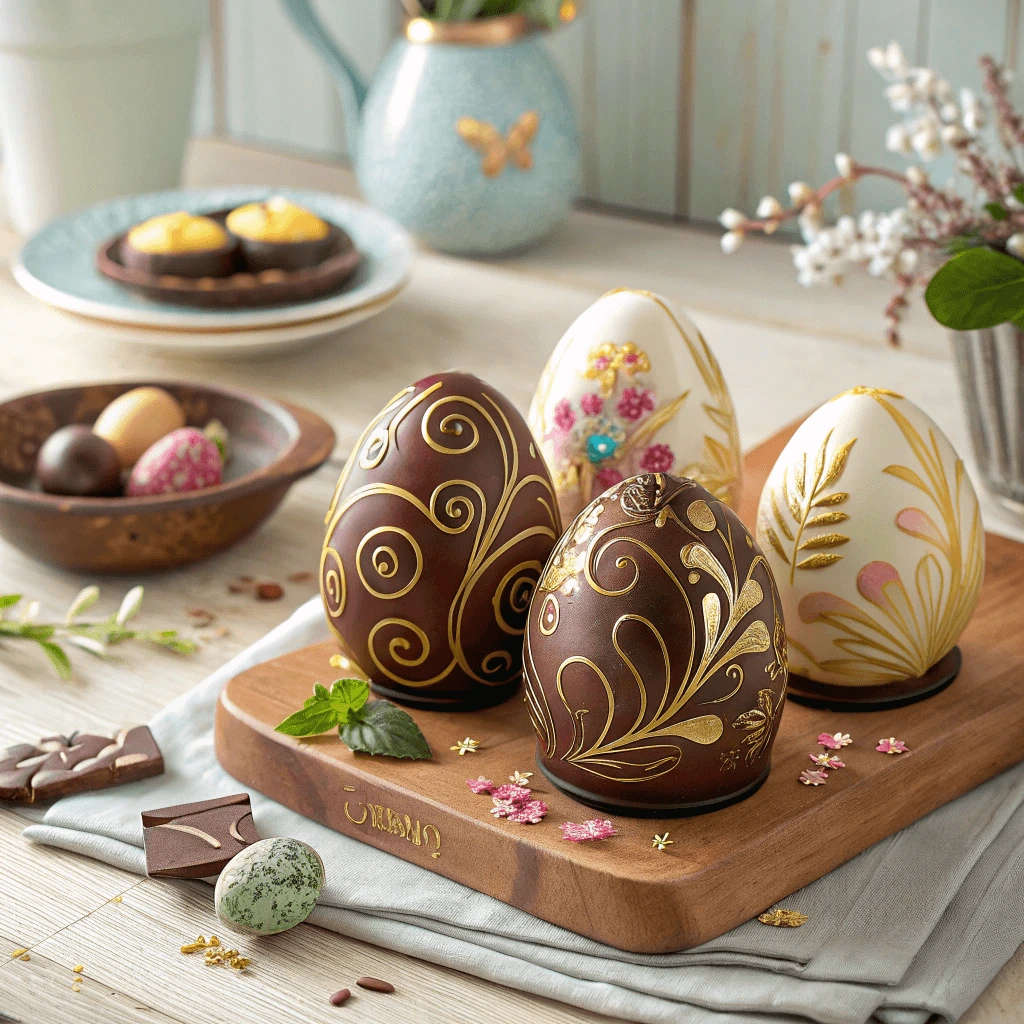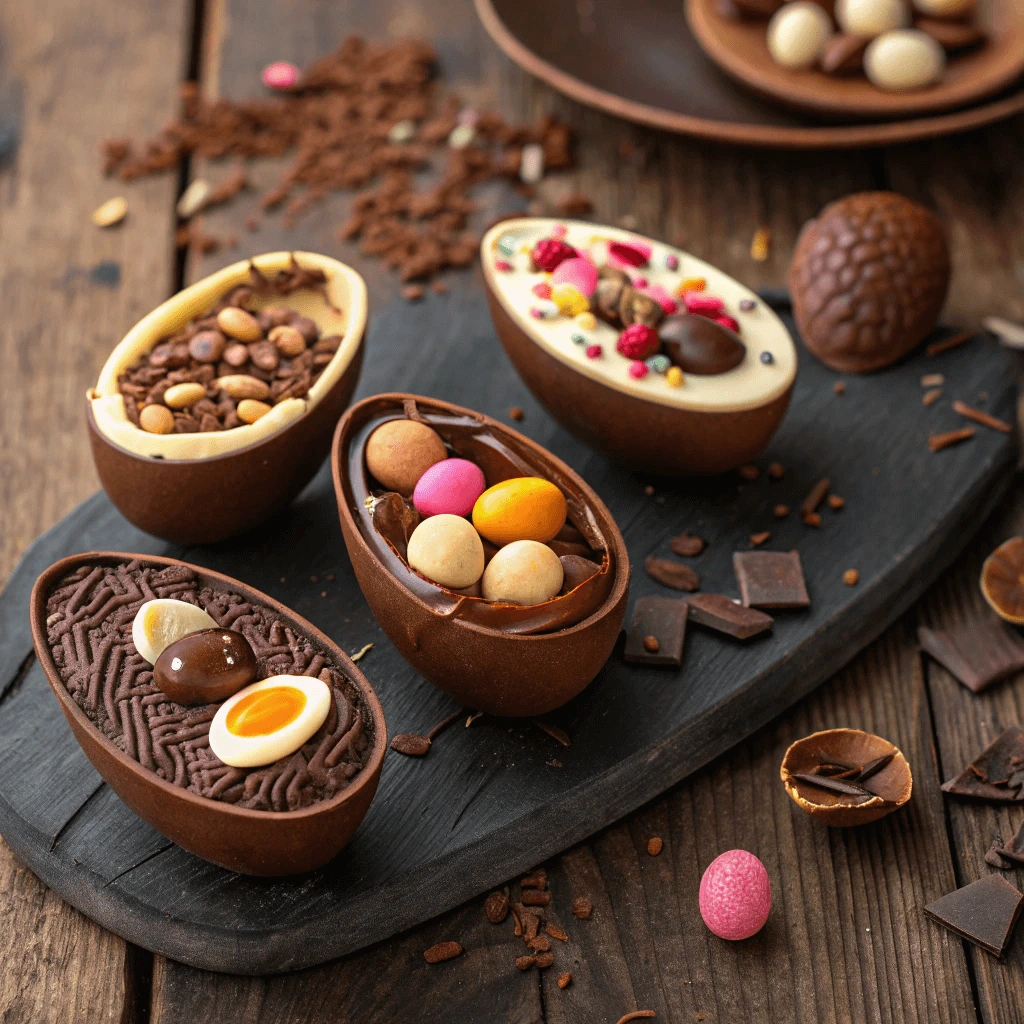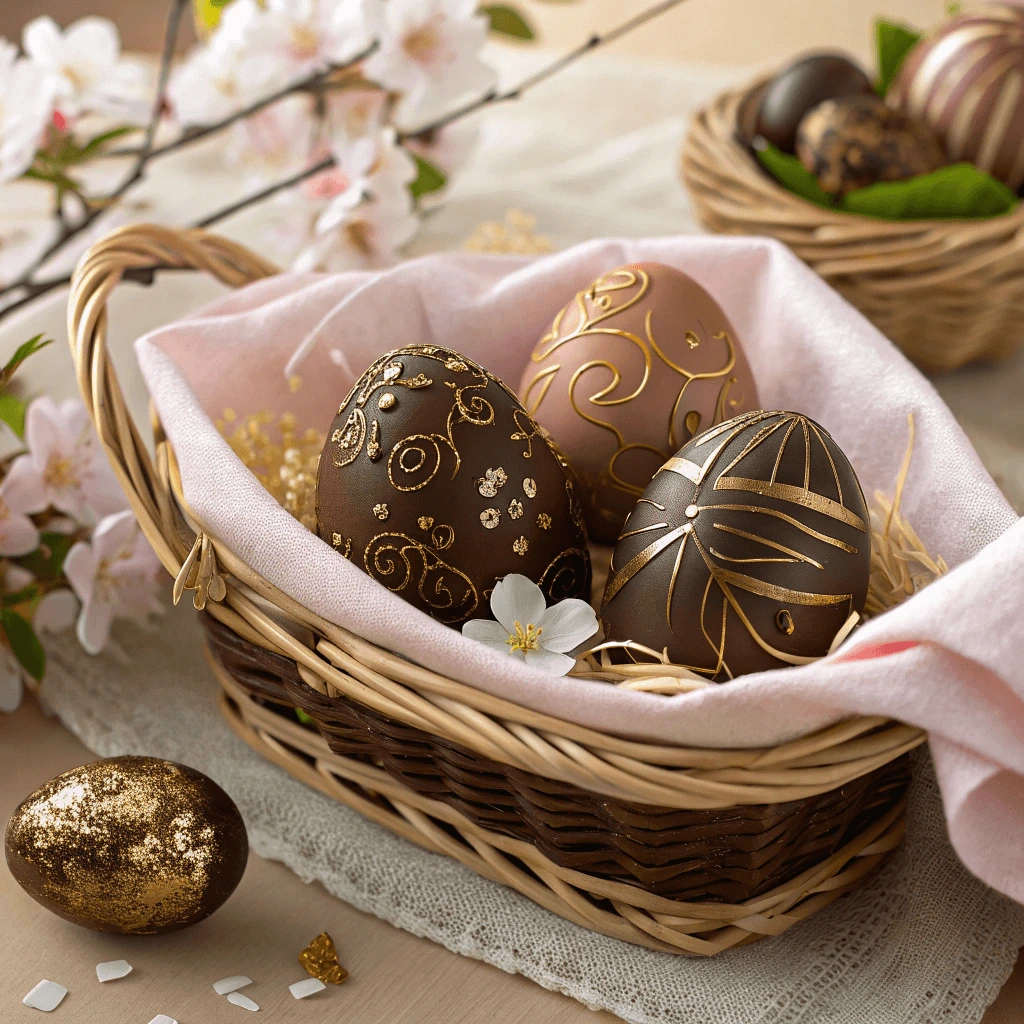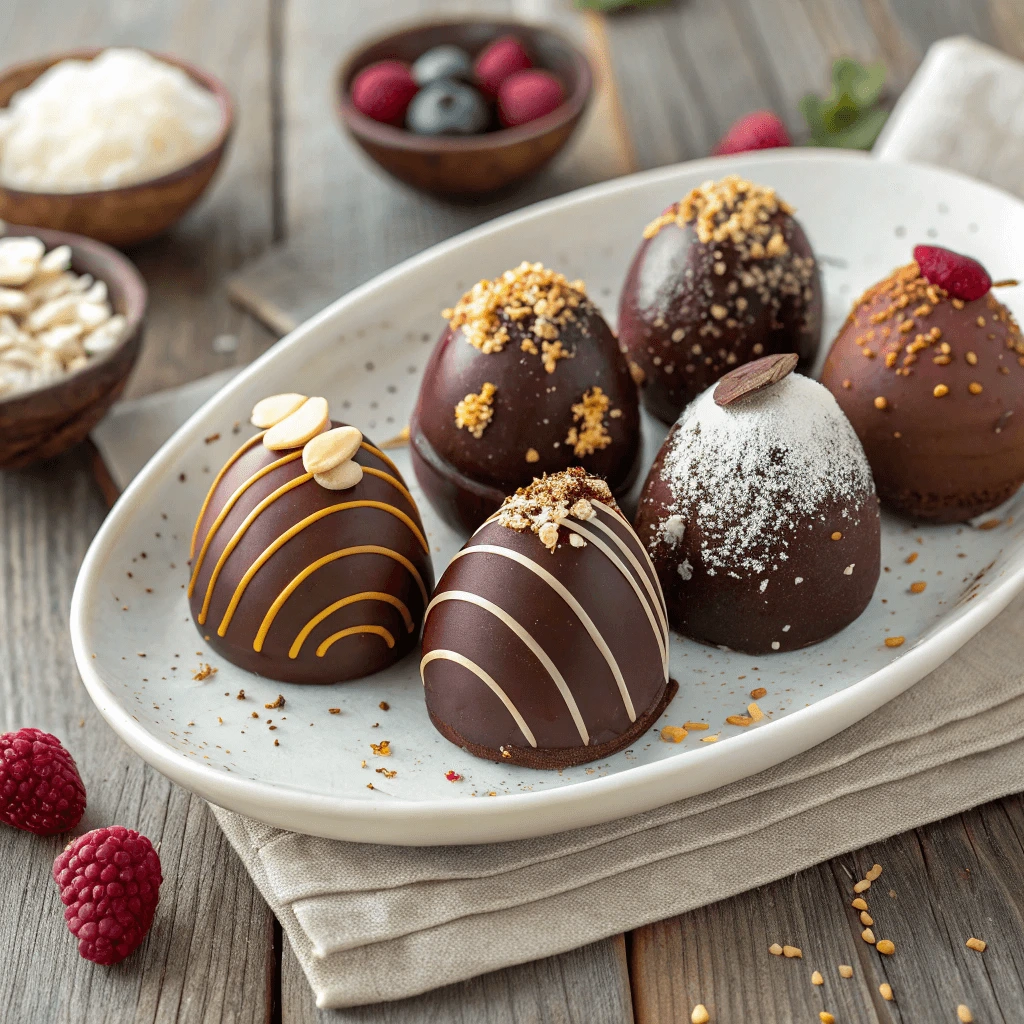There’s nothing quite as delightful as biting into a rich, creamy chocolate egg—especially when it’s homemade! Whether you’re preparing a fun Easter treat, making a special gift, or simply indulging in a chocolatey creation, homemade chocolate eggs are the perfect DIY dessert. Not only are they easy to make, but they’re also customizable, allowing you to choose your favorite chocolate, fillings, and decorations.
In this guide, we’ll walk you through everything you need to know, from choosing the best ingredients and tools to mastering the step-by-step process of molding and decorating your chocolate eggs. Plus, we’ll share expert tips to help you achieve a smooth, glossy finish and avoid common mistakes. Let’s dive in and create some delicious, homemade chocolate eggs that everyone will love!
Why Make Homemade Chocolate Eggs?

The Fun of DIY Chocolate Eggs for All Ages
Making chocolate eggs at home offers fun for kids and adults alike. A homemade chocolate eggs recipe gives everyone a chance to get creative, try new ideas, and enjoy a rewarding activity.
Family-Friendly Fun
Kids love helping with chocolate eggs. They can fill molds, add sprinkles, or help wrap the finished treats. These moments bring families together and create sweet memories.
A Creative Activity for Adults
Adults can experiment with milk, dark, or white chocolate. Many enjoy decorating with edible paint, crushed nuts, or natural food colors. A homemade chocolate eggs recipe offers endless ways to personalize each creation.
Health Benefits of Homemade Easter Candy
Choosing a homemade chocolate eggs recipe allows you to enjoy sweet treats while making healthier choices. When you control the ingredients, you can create Easter candy that suits your family’s preferences and supports well-being.
Control Over Ingredients
When you make chocolate eggs at home, you decide what goes into them. You can use high-quality dark chocolate, natural sweeteners like coconut sugar, and organic cocoa powder. These choices reduce the amount of refined sugar and artificial additives found in many store-bought Easter candies.
Add Nutrient-Rich Fillings
Homemade chocolate eggs give you the chance to add nutritious fillings. Instead of sugary creams, you can choose nut butters, fruit purees, or even seeds. These options add flavor and provide healthy fats, vitamins, and minerals.
Support for Special Diets
By making Easter candy yourself, you can adjust recipes to meet dietary needs. You can create dairy-free, vegan, or low-sugar chocolate eggs without sacrificing taste. This flexibility ensures that everyone can enjoy a delicious treat during the holiday.
Eco-Friendly and Minimal Packaging Options
Making homemade chocolate eggs not only gives you control over ingredients, but also helps you reduce waste. Choosing eco-friendly packaging options can make your Easter celebrations kinder to the planet.
Use Reusable or Compostable Materials
When you wrap your homemade chocolate eggs, try reusable materials like fabric gift wraps or small tin boxes. You can also choose compostable options such as kraft paper or natural twine. These choices cut down on plastic waste and single-use packaging.
Keep It Minimal
You don’t need fancy packaging to make chocolate eggs look special. A simple ribbon, a recycled paper tag, or a small cloth pouch can add charm without creating excess waste. By keeping packaging minimal, you save resources and reduce clutter.
Inspire Sustainable Habits
When you share chocolate eggs in eco-friendly packaging, you inspire friends and family to do the same. Small steps like these encourage others to think about sustainability during holidays and beyond.
Essential Ingredients and Tools for Your Homemade Chocolate Eggs Recipe
Choosing Between Milk, Dark, and White Chocolate
Selecting the right chocolate is key to making delicious homemade chocolate eggs. Each type—milk, dark, or white—offers unique flavors, textures, and benefits. By understanding their qualities, you can choose the best option for your recipe.
Milk Chocolate: A Classic Favorite
Milk chocolate provides a creamy, sweet flavor that appeals to both kids and adults. Its smooth texture makes it easy to work with when creating chocolate shells or decorations. If you prefer a milder taste, milk chocolate is a great choice for your homemade chocolate eggs.
Dark Chocolate: A Healthier Option
Dark chocolate contains less sugar and more cocoa solids. It offers a rich, slightly bitter taste and pairs well with nut butters or fruit fillings. Many people choose dark chocolate for its antioxidants and lower sugar content. Using dark chocolate in your homemade chocolate eggs recipe can add depth and a touch of sophistication.
White Chocolate: Sweet and Versatile
White chocolate has a creamy, sweet profile and a pale color that makes it ideal for decorative touches. Although it doesn’t contain cocoa solids, you can still use it to create fun designs or colorful patterns on your chocolate eggs. When you want to brighten your creations, white chocolate works well.
Must-Have Tools
To make a successful homemade chocolate eggs recipe, you need the right tools. These items help you create beautiful chocolate eggs with ease and confidence.
Chocolate Molds for Perfect Shapes
Chocolate molds give your eggs a smooth, professional look. You can choose from a variety of designs, from classic egg shapes to fun patterns like bunnies or flowers. Silicone molds work well because they make it easy to release the chocolate without breaking it.
Candy Thermometer for Precise Tempering
A candy thermometer helps you temper chocolate correctly. When you melt chocolate to the right temperature, you get a glossy finish and a crisp snap. Using a thermometer ensures you don’t overheat or burn the chocolate, so your eggs turn out perfectly every time.
Parchment Paper for Easy Cleanup
Lining your workspace with parchment paper keeps things tidy. You can place dipped or filled chocolate eggs on it to set without sticking. Parchment paper also makes cleanup faster, so you can focus on decorating or wrapping your treats.
Healthy Alternative
When you choose organic chocolate and natural sweeteners, you can enjoy delicious homemade chocolate eggs while making healthier, more eco-friendly choices. These alternatives add rich flavor and reduce unnecessary additives.
Why Choose Organic Chocolate?
Organic chocolate comes from cocoa beans that farmers grow without synthetic pesticides or fertilizers. This method supports soil health and protects the environment. Organic chocolate often contains fewer artificial ingredients, so your chocolate eggs taste pure and rich. Plus, many organic options come from fair-trade sources, which support ethical farming practices.
Natural Sweeteners for a Healthier Treat
You can replace refined sugar with natural sweeteners like coconut sugar, maple syrup, or honey. These sweeteners offer a gentle sweetness along with nutrients such as minerals and antioxidants. They also give your chocolate eggs a more complex, satisfying flavor.
Easy Ways to Use These Alternatives
Melt organic chocolate just as you would with regular chocolate, and mix in your natural sweetener if needed. You can adjust the level of sweetness to suit your taste. When you fill your chocolate eggs, try pairing dark organic chocolate with nut butter or fruit puree to create a wholesome, delicious treat.
Step-by-Step Guide: How to Make Chocolate Eggs at Home

Melting and Tempering Chocolate for the Perfect Shell
Creating a smooth, shiny chocolate shell for your homemade chocolate eggs requires proper melting and tempering. Mastering these techniques helps you achieve that professional finish and satisfying snap.
Melting Chocolate Correctly
Start by chopping your chocolate into small, even pieces. This allows the chocolate to melt evenly and prevents burning. Use a double boiler or microwave in short bursts, stirring frequently. Stirring helps distribute heat evenly and avoids scorching the chocolate.
Why Tempering Matters
Tempering stabilizes the cocoa butter crystals in chocolate. Without tempering, chocolate can turn dull, soft, or develop white streaks called bloom. Properly tempered chocolate hardens with a glossy finish and snaps when broken—ideal for making chocolate egg shells.
How to Temper Chocolate
There are a few simple methods to temper chocolate at home:
- Seeding Method: Melt two-thirds of the chocolate to about 115°F (46°C), then add the remaining chopped chocolate and stir until the temperature cools to about 82°F (28°C). Reheat gently to 88–90°F (31–32°C) before using.
- Tabling Method: Pour melted chocolate onto a cool marble surface and spread it out with a spatula to cool, then return it to the bowl and reheat slightly.
Use a candy thermometer to track temperatures accurately. This ensures the chocolate stays within the right range for tempering.
Filling and Sealing Your Chocolate Eggs
Filling and sealing your homemade chocolate eggs properly ensures a delicious treat that holds its shape and flavor. Following these steps carefully will help you create beautiful, tasty eggs every time.
Preparing the Filling
Start by choosing your filling—popular options include nut butters, fruit purees, ganache, or caramel. Make sure the filling is smooth and not too runny to avoid leaks. If needed, chill the filling beforehand to help it firm up inside the egg.
Adding the Filling
Pour or spoon your filling carefully into one half of the chocolate shell. Fill it generously but leave a small gap near the edge to allow room for sealing. Take your time to avoid spilling over the edges, which can make sealing difficult.
Sealing the Eggs
To seal the eggs, warm a clean plate or baking sheet slightly. Place the empty half of the chocolate shell on the warm surface for a few seconds to melt the edge just enough for bonding. Quickly press the filled half onto the melted edge and hold gently to join them.
Alternatively, use a small amount of melted chocolate as “glue.” Apply it around the edges of one half, then press the halves together. Use your fingers or a spatula to smooth the seam and remove excess chocolate.
Setting and Storing
Place the sealed eggs in a cool area or refrigerator to allow the chocolate to harden completely. Avoid touching the surface during this time to maintain a smooth finish. Once set, store your chocolate eggs in an airtight container in a cool, dry place to keep them fresh.
Healthy Alternative
Opting for healthy fillings elevates your homemade chocolate eggs by adding nutrition without compromising flavor. Incorporating nut butters, fruit purees, and coconut sugar creates delicious and wholesome treats everyone can enjoy.
Nut Butters: Creamy and Nutritious
Almond, peanut, or cashew butters bring a rich, creamy texture and satisfying taste to your chocolate eggs. These nut butters supply healthy fats, protein, and essential vitamins. To reduce sugar, select natural, unsweetened varieties. Additionally, mixing nut butters with a small amount of coconut sugar or honey can enhance sweetness naturally.
Fruit Purees: Naturally Sweet and Refreshing
Fruit purees offer a refreshing, fruity contrast to the richness of chocolate. Berries, mango, or banana purees not only add natural sweetness but also provide vitamins and fiber. For the best results, gently cook the fruit puree to thicken it, or blend fresh fruit until smooth. To boost the flavor, try adding a pinch of cinnamon or a splash of vanilla extract.
Coconut Sugar: A Natural Sweetener
Coconut sugar delivers a subtle caramel flavor along with minerals like iron and zinc. It serves as a healthier alternative to refined sugar when sweetening your fillings. Warm the coconut sugar slightly to help it dissolve better, and stir it well into your nut butter or fruit puree fillings. This simple step improves texture and sweetness balance.
Creative Decoration and Gift-Wrapping Ideas

Decorating with Sprinkles, Edible Paint, and Nuts
Decorating your homemade chocolate eggs adds a fun, creative touch that makes each treat unique and festive. Using sprinkles, edible paint, and nuts lets you customize your eggs with color, texture, and flavor.
Using Sprinkles for a Playful Look
Sprinkles bring vibrant colors and fun shapes to your chocolate eggs. After pouring melted chocolate into the molds, sprinkle your favorite decorations onto the surface before the chocolate sets. Choose from rainbow nonpareils, metallic stars, or themed shapes to match the occasion. Sprinkles add crunch and visual appeal, making your eggs stand out.
Painting with Edible Colors
Edible paint allows you to create beautiful patterns and designs on the chocolate surface. Use food-safe brushes and colored cocoa butter or edible powders diluted with a bit of alcohol or clear extract. Paint stripes, polka dots, or floral designs for a professional finish. Let each layer dry before adding another to avoid smudging.
Adding Nuts for Texture and Flavor
Chopped nuts add a delightful crunch and a natural flavor contrast to smooth chocolate. Sprinkle toasted almonds, pistachios, or hazelnuts over the melted chocolate or press them gently into the surface before it hardens. Nuts also boost the nutritional value, providing healthy fats and protein.
Tips for Best Results
Decorate your chocolate eggs on a cool surface to prevent melting. Work quickly but carefully to apply decorations before the chocolate fully sets. Store decorated eggs in a cool, dry place to preserve their appearance and texture.
Using Natural Food Coloring and Edible Flowers for a Healthy Twist
Adding color and decoration to your homemade chocolate eggs can be both beautiful and healthy. Natural food coloring and edible flowers bring vibrant hues and delicate flavors without artificial additives.
Benefits of Natural Food Coloring
Natural food coloring comes from fruits, vegetables, and spices like beetroot, turmeric, spirulina, and paprika. Unlike synthetic dyes, these natural sources provide antioxidants and nutrients. They create attractive shades of red, yellow, green, and orange while keeping your treats wholesome. To use them, simply mix powdered or liquid natural colorants into melted chocolate or fillings.
How to Use Edible Flowers
Edible flowers like violets, pansies, and calendula offer subtle floral notes and stunning visual appeal. You can press fresh flowers onto the chocolate before it hardens or sprinkle dried petals inside the filling for a surprise taste and texture. Ensure you choose flowers labeled as edible and free from pesticides.
Tips for Incorporating Natural Colors and Flowers
Start with small amounts of natural coloring to achieve your desired shade without overpowering the chocolate’s flavor. Gradually add more until you reach the perfect hue. When decorating with edible flowers, place them carefully to prevent wilting. Use a light touch to maintain the eggs’ smooth surface and appealing look.
Eco-Friendly Gift Wrapping: Reusable and Minimal Packaging
When giving homemade chocolate eggs as gifts, choosing eco-friendly wrapping shows care for both the recipient and the environment. Using reusable and minimal packaging reduces waste while still creating a beautiful presentation.
Benefits of Reusable Packaging
Reusable gift wraps, such as fabric bags, cotton wraps, or decorative boxes, offer an environmentally conscious alternative to disposable materials. They allow recipients to repurpose the packaging for storage or future gifts. By choosing reusable options, you minimize landfill waste and help reduce plastic consumption.
Minimal Packaging Ideas That Impress
Sometimes less is more. Minimal packaging uses simple materials like brown kraft paper, twine, and dried flowers to create a charming rustic look. This style reduces excess waste and highlights the care and effort you put into making the chocolate eggs. Additionally, you can decorate with hand-tied ribbons or natural elements like cinnamon sticks or fresh herbs for an extra personal touch.
Tips for Sustainable Wrapping
To keep your wrapping eco-friendly, avoid plastic tapes and opt for paper-based tape or natural twine instead. When possible, reuse ribbons, bags, and boxes from previous gifts. Moreover, consider including a small note explaining your choice of sustainable packaging; it encourages others to think green too.
Storage, Leftovers, and Delicious Uses Beyond Easter
Proper Storage to Keep Chocolate Eggs Fresh
Keeping your homemade chocolate eggs fresh ensures they stay delicious and maintain their texture for as long as possible. Storing them correctly helps prevent melting, blooming, and flavor loss.
Ideal Temperature and Environment
Chocolate eggs stay fresh best when stored in a cool, dry place. Aim for a temperature between 60°F and 70°F (15°C to 21°C). Avoid humid areas, as moisture can cause sugar bloom—a white, powdery film that appears on the surface. Similarly, prevent direct sunlight or heat sources from touching the chocolate, which may cause melting or softening.
Avoid Refrigeration When Possible
Although refrigeration might seem like a good idea, it often causes condensation when the eggs are brought back to room temperature. This moisture can alter texture and appearance. However, if your environment is warm or humid, refrigerate the eggs in an airtight container to minimize moisture exposure. Before serving, allow the eggs to come to room temperature gradually for the best taste and texture.
Use Airtight Containers and Wrapping
Wrap each chocolate egg individually in wax paper, parchment paper, or food-safe plastic wrap. Then, place them inside an airtight container to protect from air exposure, which can dry out the chocolate and dull the flavor. You can also use reusable silicone containers or glass jars to reduce waste.
Keep Chocolate Away from Strong Odors
Chocolate easily absorbs odors from surrounding foods. Store eggs away from strong-smelling items like onions, garlic, or spices to keep their delicate flavor intact.
Creative Ideas for Using Leftover Chocolate Eggs
Leftover chocolate eggs don’t have to go to waste. You can transform them into delicious treats and add a fun twist to your everyday desserts.
Make Decadent Hot Chocolate
Chop leftover chocolate eggs into small pieces and melt them into warm milk or plant-based alternatives. Stir continuously until smooth to create a rich, homemade hot chocolate. You can enhance the drink by adding cinnamon, vanilla extract, or a pinch of chili powder for a spicy kick.
Bake Chocolate-Infused Desserts
Incorporate chopped chocolate eggs into brownies, cookies, or muffins for an indulgent surprise. They melt during baking, creating gooey pockets of chocolate. Alternatively, sprinkle small pieces on top of cakes or cupcakes before baking to add texture and flavor.
Create Chocolate Bark or Trail Mix
Melt leftover chocolate eggs and spread the liquid onto parchment paper. Add nuts, dried fruits, seeds, or coconut flakes before the chocolate hardens. Once set, break it into shards for a delicious homemade chocolate bark. You can also toss small chocolate chunks into trail mix for a sweet, energizing snack.
Craft Homemade Chocolate Fondue
Use your leftover chocolate eggs as a base for a chocolate fondue. Melt the chocolate gently, then dip fruits, marshmallows, or pretzels. This makes a fun, interactive dessert perfect for gatherings or family nights.
Blend Into Smoothies or Milkshakes
Add pieces of leftover chocolate eggs into your favorite smoothie or milkshake recipe. Blend them with bananas, berries, or peanut butter to create a creamy and chocolaty drink.
Healthy Alternative: Minimal Packaging and Cool, Dry Storage Tips
Choosing minimal packaging for your homemade chocolate eggs benefits both your health and the environment. Additionally, proper storage keeps your treats fresh and tasty for longer.
Why Minimal Packaging Matters
Reducing packaging waste decreases environmental impact and limits your exposure to potentially harmful chemicals found in some plastics. Instead of using excessive wrapping, opt for reusable materials like beeswax wraps, glass jars, or cloth bags. These eco-friendly options not only protect your chocolate eggs but also help maintain their freshness naturally.
Tips for Using Minimal Packaging
Wrap each chocolate egg in parchment or wax paper to prevent sticking. Then, place the wrapped eggs into a reusable container or basket. If you want to add a decorative touch, use natural twine or recycled ribbons. This approach reduces waste and looks charming when gifting.
Ideal Storage Conditions for Chocolate Eggs
Store your chocolate eggs in a cool, dry place away from direct sunlight. Aim for temperatures between 60°F and 70°F (15°C to 21°C) to avoid melting or blooming—the white, powdery film that sometimes appears on chocolate. Also, keep the eggs away from strong odors, which chocolate easily absorbs and can alter its taste.
Avoid Refrigeration When Possible
While refrigeration can extend shelf life in warm climates, it often causes condensation when the eggs return to room temperature. This moisture affects the texture and appearance of the chocolate. If you must refrigerate, seal the eggs tightly in an airtight container to minimize moisture exposure. Always allow chilled chocolate eggs to reach room temperature gradually before serving.
Conclusion
Making homemade chocolate eggs is a delightful and rewarding experience that anyone can enjoy. This easy recipe combines fun creativity with delicious results, perfect for Easter celebrations or any special occasion. By choosing quality ingredients and simple techniques, you create personalized treats that everyone will love. Plus, you can explore healthy alternatives and eco-friendly packaging to make your chocolate eggs even better. Give this recipe a try and enjoy the satisfaction of crafting sweet, homemade delights that bring joy to your family and friends!
